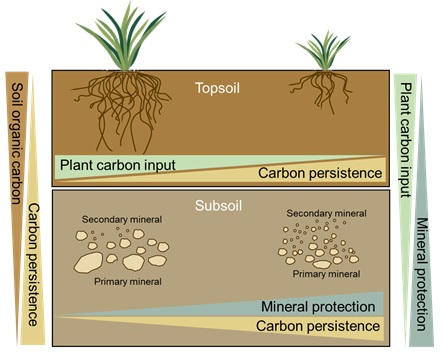As the largest carbon (C) stock in the terrestrial biosphere, soil constitutes an important component of the global C cycle. Even a small proportion of soil C loss may induce significant fluctuation of atmospheric carbon dioxide (CO2) concentration and trigger a potential positive feedback to climate change. Therefore, elucidating the processes underlying the persistence of soil organic matter (SOM) is a prerequisite for projecting soil C feedback to climate change.
However, compared to the abiotic factors (i.e. climate, mineral protection and SOM chemical composition), the potential role of plant C input in regulating the multi-layer SOM preservation over broad geographic scales remains poorly understood. Particularly, no empirical work has attempted to explore the relative importance of plant C input in relation to other abiotic factors at various soil depths.
To fill up this research gap, a research team led by Prof. YANG Yuanhe from the Institute of Botany, Chinese Academy of Sciences quantified the relative importance of plant C input in relation to other factors (i.e. climate, mineral protection and SOM chemical composition) in governing SOM persistence within different soil layers.
Based on large-scale soil radiocarbon (Δ14C) measurements on the Tibetan Plateau, they revealed that plant C input was the major contributor to topsoil C destabilisation despite the significant associations of topsoil Δ14C with climatic and mineral variables as well as SOM chemical composition.
By contrast, the role of plant C input decreased in deep soils, where mineral protection by iron–aluminium oxides and cations became more important in preserving SOM. These regional observations were confirmed by a global synthesis derived from the International Soil Radiocarbon Database (ISRaD).
These findings illustrate different effects of plant C input on SOM persistence across soil layers, providing new insights for models to better predict multi-layer soil C dynamics under changing environments.
This work was published in Ecology Letters entitled "Soil carbon persistence governed by plant input and mineral protection at the regional and global scales". 
Soil carbon persistence governed by plant input and mineral protection (By IBCAS)
Article Link:https://onlinelibrary.wiley.com/doi/full/10.1111/ele.13723
Contact:
Email:yhyang@ibcas.ac.cn
Institute of Botany, Chinese Academy of Sciences
As the largest carbon (C) stock in the terrestrial biosphere, soil constitutes an important component of the global C cycle. Even a small proportion of soil C loss may induce significant fluctuation of atmospheric carbon dioxide (CO2) concentration and trigger a potential positive feedback to climate change. Therefore, elucidating the processes underlying the persistence of soil organic matter (SOM) is a prerequisite for projecting soil C feedback to climate change.
However, compared to the abiotic factors (i.e. climate, mineral protection and SOM chemical composition), the potential role of plant C input in regulating the multi-layer SOM preservation over broad geographic scales remains poorly understood. Particularly, no empirical work has attempted to explore the relative importance of plant C input in relation to other abiotic factors at various soil depths.
To fill up this research gap, a research team led by Prof. YANG Yuanhe from the Institute of Botany, Chinese Academy of Sciences quantified the relative importance of plant C input in relation to other factors (i.e. climate, mineral protection and SOM chemical composition) in governing SOM persistence within different soil layers.
Based on large-scale soil radiocarbon (Δ14C) measurements on the Tibetan Plateau, they revealed that plant C input was the major contributor to topsoil C destabilisation despite the significant associations of topsoil Δ14C with climatic and mineral variables as well as SOM chemical composition.
By contrast, the role of plant C input decreased in deep soils, where mineral protection by iron–aluminium oxides and cations became more important in preserving SOM. These regional observations were confirmed by a global synthesis derived from the International Soil Radiocarbon Database (ISRaD).
These findings illustrate different effects of plant C input on SOM persistence across soil layers, providing new insights for models to better predict multi-layer soil C dynamics under changing environments.

Soil carbon persistence governed by plant input and mineral protection (By IBCAS)
Article Link:https://onlinelibrary.wiley.com/doi/full/10.1111/ele.13723
Contact:
Email:yhyang@ibcas.ac.cn
Institute of Botany, Chinese Academy of Sciences
